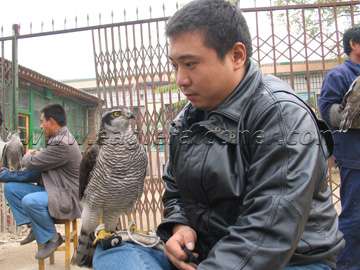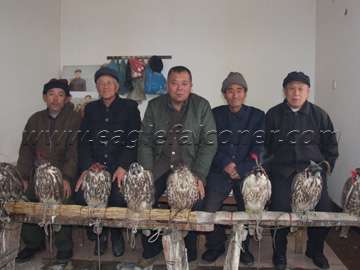I am more use to waking up and feeling the planet breathing beneath me.
This morning I awoke to the full roar of humanity and I knew I was back in urban China. It is as if every person is hell bent on making as much noise as possible, human noise at this volume is so irritating, and brings the reality of city life in with a bang.
I could not be at more extremes, essentially I am a country boy at heart and love waking to the sound of bird song, but something keeps bringing me back to this mad intense environment.
The fascination for me is the exploration of China’s falconry tradition by modern participants of the art. The Government is not sympathetic, and in some parts of China, down right hostile to anyone keeping raptors. This makes it extremely difficult for anyone especially a foreigner, to find any information about the practise of falconry in any area of China.
It is a long slow process and requires much patience, little can be achieved in just one quick visit.
Each time I return, new avenues are beginning to open up to me as my network of friends grows, and I am welcomed into new areas of Chinese falconry.
This is my tenth journey into China and as I sit on my bed in the suburbs of Beijing typing my journal of the first two weeks, I confess this has been the most productive journey so far.
I feel a real acceptance from falconers and an eager willingness to show me anything I wish to see.
In the first week I spent a few days in the countryside at a village hunting lodge of a city falconer  friend of mine. This was a return visit for me as last season I enjoyed a few days with the goshawks hunting hares in the maze cornfields. Now it is earlier in the season and he is training the new seasons goshawks. It is the tradition to release their hawks at the end of winter and trap new hawks in the following autumn. friend of mine. This was a return visit for me as last season I enjoyed a few days with the goshawks hunting hares in the maze cornfields. Now it is earlier in the season and he is training the new seasons goshawks. It is the tradition to release their hawks at the end of winter and trap new hawks in the following autumn.
Wild adult haggard and passage birds are manned and ready for hunting within a few weeks. It was a treat to experience a few days of the process with the added knowledge that I should be able to return to witness these hawks being entered some time in the next week or two.
WuDi is my host, a young man so dedicated to falconry he has forsaken family tradition to follow his love of hawks.
In China, a young person is expected to earn as good a living as they can to better the family unit. Marriage and children is the next phase of your life, and for the son of the family even more pressure is placed on your shoulders to continue the family line.
WuDi, gave up a good job and so far has resisted his parents longing for him to settle down with a nice girl, get married and start a family. For him the love of the goshawk is what makes him happy and once he collects his new seasons hawk from the trappers he moves away from the city and into his hunting lodge for the winter hawking.
 A Beijing city boy, WuDi saw his first hawk at a bird market when he was nine years old. This vision left him in awe of anything hawk like. At fourteen he could hold this passion at bay no longer and he stole a packet of his fathers cigarettes and exchanged them for a Japanese Sparrow Hawk accipiter gularis. A Beijing city boy, WuDi saw his first hawk at a bird market when he was nine years old. This vision left him in awe of anything hawk like. At fourteen he could hold this passion at bay no longer and he stole a packet of his fathers cigarettes and exchanged them for a Japanese Sparrow Hawk accipiter gularis.
These are delicate birds and are flown in the spring and early summer months, WuDi had little idea of hawk management and soon the sparrow hawk died.
Devastated by this set back but not deterred he waited and learned as much as he could from the older men in the markets. By the time he was eighteen he had been under the guidance of a Mr. Wangcheng a falconer who taught him to fly a Chinese sparrow hawk at sparrows around the alleyways and back streets of Beijing.
As WuDi’s falconry ambitions progressed to a goshawk, the problems of falconry being illegal in the Peoples Republic of China had to be taken more seriously. Whereas the authorities would turn a bit of a blind eye to a kid with a sparrow hawk, they were not going to allow a goshawk to be paraded or hunted within the capitol city.
Undeterred by this irritant he contacted his Auntie who lived in the countryside south of Beijing and asked if he could come and stay for the winter.
Guan county is flat agricultural land that spreads for hundreds of miles. No hedges, few trees and very few ditches, it is made up of strip crops of maze, cotton, tobacco and vegetables.
The brown hares are the main and almost only quarry of the trained goshawk. Pheasants are almost unknown in this part of China which is such a shame as they would add some excitement whilst looking for hares.
Having found his true element, WuDi would spend every winter at his Aunties in the countryside. Each winter he would train a newly trapped female goshawk, and hunt with her until the end of January, at which time he would release her back to the wild.
In 2003, WuDi’s grandfather passed away but he left him the ownership of his house in the village in Guan county. This is now the famous hunting lodge where WuDi and his friends from Beijing retreat to each winter with their hawks.
I have been lucky to spend time at the lodge on a couple of visits and meet experienced visiting falconers with their hawks, falcons and shrikes.
The enclosed yard houses the hawk accommodation, as well as the dog kennels and pigeon loft. As  you enter the lodge you are faced with a low screen perch where the latest hawk being manned is tethered. That is if it is not already on somebody's fist. you enter the lodge you are faced with a low screen perch where the latest hawk being manned is tethered. That is if it is not already on somebody's fist.
With a house full of falconers a hawk never has a minutes peace, as soon as one falconer tethers the hawk to the perch then another one picks it up and takes it for a walk, or just into the group discussion.
All this constant handling can man a wild haggard gos within fourteen to twenty days to be as tame as any imprint I have seen.
Yes, they are waked in the first days but not as we were led to believe by T.H.White, this is not a battle between hawk and man.
Instead the Chinese man the new hawk for about twenty hours, they take it in turns and then let the hawk rest and sleep for a few hours, then start again. Within days the hawk is calm and relaxed and ready to start flying to the fist.
Last October, Wudi gathered up a Jack Merlin from a friend for some entertainment for me. We borrowed a couple of bicycles from neighbours and set out around the dirt alleyways between the village houses. We were looking for sparrows, and once spotted the Merlin was laid in the palm of the right hand, we then continued our approach until within twenty feet or so of the sparrows. The Merlin was thrown like javelin at the exploding flock of sparrows. Helped by the thrust, these miniature rockets are so fast it is hard to focus on the action. Needless to say, he rarely missed, and within no time we had four sparrows in the bag.
WuDi’s love may be the goshawk but like many falconers he enjoys both longwings as well shortwings. He planned to accompany me on a visit to one of his friends in the next county, and so we set off in his battered truck in the early hours one morning.
Mr. Lu was in the construction industry and very successful, he had always loved falcons and these days employs a team of experienced local falconers just to look after his TuHu’s.
 The TuHu is Chinese for a female Saker falcon and it translates to “Hare Tiger”, the male Saker or Sakeret is not used in Chinese falconry. The TuHu is Chinese for a female Saker falcon and it translates to “Hare Tiger”, the male Saker or Sakeret is not used in Chinese falconry.
As the name suggests, the TuHu’s primary quarry is the big brown hare. She is flown out of the hood after fleeing hares that usually have a couple of longdogs in hot pursuit and keeping the chase at top speed.
Mr.Lu’s TuHu’s are flown every day, and generally each falcon in the team catches a hare every day and is fed a good crop on the kill. Yet remarkable, and due to the skill of these falconers, they are ready to hunt the next day.
We went out for three days with these TuHu’s and enjoyed some excellent flights, a lot of ground was covered to find the quarry but we managed a kill for each falcon in the team on every day.
Mr.Lu would join us at some time within the day, locating our position by mobile telephone.
For me the experiences I enjoy with my Chinese falconry friends, enlightens me to the methods I struggled with as a young falconer learning to man passage goshawks, with only the aid of ancient text. I look back and wonder, had I been able to visit China in those early years and learn from this unbroken knowledge.
|
